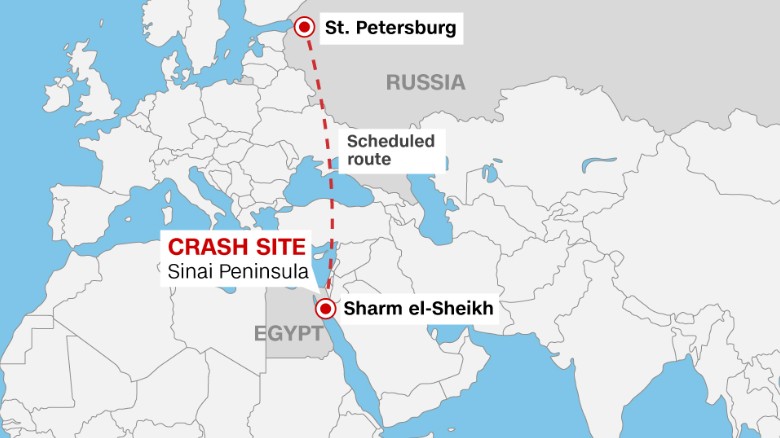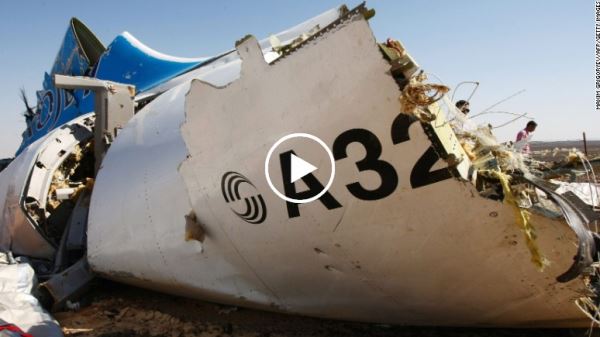Radar
Flight 9268 was on its way from the Egyptian resort of Sharm el-Sheikh to St. Petersburg early Saturday when it dropped off radar about 23 minutes into the flight, Egyptian officials say.
Air traffic controllers apparently didn't receive any distress calls.
The website Flightradar24, which tracks aircraft around the world, said it had received data from the Russian plane suggesting sharp changes in altitude and a dramatic decrease in ground speed before the signal was lost.

Satellite data
A U.S. military satellite detected a midair heat flash from the Russian airliner before the plane crashed Saturday, a U.S. official told CNN.
Intelligence analysis has ruled out that the Russian commercial airplane was struck by a missile, but the new information suggests that there was a catastrophic in-flight event -- including possibly a bomb, though experts are considering other explanations, according to U.S. officials.
Analysts say heat flashes could be tied to a range of possibilities, including a bomb blast, a malfunctioning engine exploding or a structural problem causing a fire on the plane.

Black boxes
Egyptian officials have said they are finishing fieldwork first, and then will go on to investigate the data in the black boxes. Experts started retrieving data from the recorders on Monday, Egypt's Civil Aviation Ministry said.
Photo of one of Flight 9268's "black boxes" released by Egypt's Ministry of Civil Aviation.Russia's privately owned Interfax news agency quoted an unnamed source in Cairo as saying the plane's cockpit voice recorder had captured uncharacteristic sounds the moment before the flight disappeared.
It cited the source as saying that an "unexpected' and "nonstandard (emergency)" occurred "instantly," which was why the pilots failed to send an emergency or alarm signal.
A top Russian aviation official has said the plane broke apart in midair. Sounds in the black-box recording could help investigators determine what caused that to happen, said Peter Goelz, a CNN aviation analyst and former managing director of the U.S. National Transportation Safety Board.
"You can tell whether it is a high-order explosion, or a more low-order event, like a decompression and a tearing apart of the aircraft," he said.
The wreckage
The Egyptian committee investigating the Metrojet plane crash is expected to finish fieldwork on Tuesday evening, Egyptian Civil Aviation Minister Hossam Kamel said in a news statement Tuesday.
That's a sign that investigators will soon be closer to figuring out what happened, said Alan Diehl, a former accident investigator for the U.S. National Transportation Safety Board, the Federal Aviation Administration and the U.S. Air Force.
"This airplane went down in the desert ... and that makes it a lot easier to locate the critical pieces. But that is very quick, if they can do that and get the forensic wreckage evidence into the labs, that will be good news," he said.
Russian state media has reported that so far, investigators haven't found any traces of explosive devices in the debris.
Explosives expert Chris Owen, from Alford Technologies, told CNN that if swabs had been taken from plane debris quickly -- while the wreckage was dry -- it could be possible to identify any explosive residue in a lab.
"However, there would probably be quicker and more obvious evidence from the type of damage sustained by bits and pieces around the bomb," he said. "Surfaces in the vicinity of any explosion would be expected to be bent, perforated, petaled, spalled, sheared, frayed, charred (especially fibers), melded by impact, and otherwise characteristically damaged."
Owen said it would be hard to rule out a bomb blast just because evidence of one had not been discovered. "If a bomb is ruled out, it will likely be because another cause has been found," he said.
The victims
Most of the bodies retrieved at the crash site are intact, a medical source in Sinai told CNN on Monday, and showed no major burns.
On the bodies of victims recovered so far, investigators haven't found any sign of explosive impact,Russian state media reported Tuesday, citing unnamed sources.
Russia's state-run TASS news agency reported that Russian and Egyptian experts had not found any blast-related trauma during their preliminary examination of the bodies, citing a Russian source within the investigation.
The plane's maintenance history
The A321-200 was built in 1997, and the airline company Kogalymavia, which flies under the name Metrojet, had been operating it since 2012, Airbus said. The aircraft had clocked around 56,000 flight hours over the course of nearly 21,000 flights, the plane maker said.
Metrojet official Alexander Smirnov said the airline had ruled out technical problems and human error. Protection systems on the plane would have prevented it from crashing, he said, even if there were major errors in the pilot's control equipment. But authorities have said it's too soon to rule out any possible cause for the crash.
So far, officials have said all its inspections were in order.
The aircraft passed a routine inspection before takeoff, Egyptian Airports Co. chief Adel Al-Mahjoob said Saturday.
According to the Aviation Safety Network, which tracks aircraft incidents, the same plane's tail struck a runway while landing in Cairo in 2001 and required repair. At the time, the aircraft was registered to the Lebanese carrier Middle East Airlines, registration records show.
Kogalymavia's Andrei Averyanov said the plane had been damaged in 2001, but had most recently been thoroughly checked for cracks in 2013. Not enough time had passed for major cracks to develop to a critical size since then, he said.
Smirnov, the Metrojet official, said that he had personally flown the plane in recent months and that it was "pristine."
CNN's Susannah Cullinane, Barbara Starr, Sara Sirgany, Nic Robertson, Alla Eschenko, Elena Sandyrev, Arwa Damon, Nancy Leung and Radina Gigova contributed to this report.